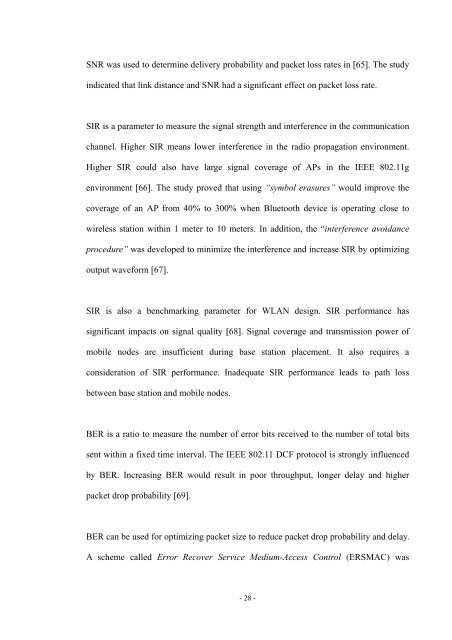An Investigation of the Impact of Signal Strength on Wi-Fi Link ...
An Investigation of the Impact of Signal Strength on Wi-Fi Link ...
An Investigation of the Impact of Signal Strength on Wi-Fi Link ...
You also want an ePaper? Increase the reach of your titles
YUMPU automatically turns print PDFs into web optimized ePapers that Google loves.
SNR was used to determine delivery probability and packet loss rates in [65]. The study<br />
indicated that link distance and SNR had a significant effect <strong>on</strong> packet loss rate.<br />
SIR is a parameter to measure <str<strong>on</strong>g>the</str<strong>on</strong>g> signal strength and interference in <str<strong>on</strong>g>the</str<strong>on</strong>g> communicati<strong>on</strong><br />
channel. Higher SIR means lower interference in <str<strong>on</strong>g>the</str<strong>on</strong>g> radio propagati<strong>on</strong> envir<strong>on</strong>ment.<br />
Higher SIR could also have large signal coverage <str<strong>on</strong>g>of</str<strong>on</strong>g> APs in <str<strong>on</strong>g>the</str<strong>on</strong>g> IEEE 802.11g<br />
envir<strong>on</strong>ment [66]. The study proved that using “symbol erasures” would improve <str<strong>on</strong>g>the</str<strong>on</strong>g><br />
coverage <str<strong>on</strong>g>of</str<strong>on</strong>g> an AP from 40% to 300% when Bluetooth device is operating close to<br />
wireless stati<strong>on</strong> within 1 meter to 10 meters. In additi<strong>on</strong>, <str<strong>on</strong>g>the</str<strong>on</strong>g> “interference avoidance<br />
procedure” was developed to minimize <str<strong>on</strong>g>the</str<strong>on</strong>g> interference and increase SIR by optimizing<br />
output waveform [67].<br />
SIR is also a benchmarking parameter for WLAN design. SIR performance has<br />
significant impacts <strong>on</strong> signal quality [68]. <str<strong>on</strong>g>Signal</str<strong>on</strong>g> coverage and transmissi<strong>on</strong> power <str<strong>on</strong>g>of</str<strong>on</strong>g><br />
mobile nodes are insufficient during base stati<strong>on</strong> placement. It also requires a<br />
c<strong>on</strong>siderati<strong>on</strong> <str<strong>on</strong>g>of</str<strong>on</strong>g> SIR performance. Inadequate SIR performance leads to path loss<br />
between base stati<strong>on</strong> and mobile nodes.<br />
BER is a ratio to measure <str<strong>on</strong>g>the</str<strong>on</strong>g> number <str<strong>on</strong>g>of</str<strong>on</strong>g> error bits received to <str<strong>on</strong>g>the</str<strong>on</strong>g> number <str<strong>on</strong>g>of</str<strong>on</strong>g> total bits<br />
sent within a fixed time interval. The IEEE 802.11 DCF protocol is str<strong>on</strong>gly influenced<br />
by BER. Increasing BER would result in poor throughput, l<strong>on</strong>ger delay and higher<br />
packet drop probability [69].<br />
BER can be used for optimizing packet size to reduce packet drop probability and delay.<br />
A scheme called Error Recover Service Medium-Access C<strong>on</strong>trol (ERSMAC) was<br />
- 28 -
















